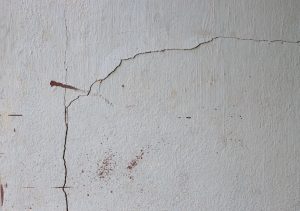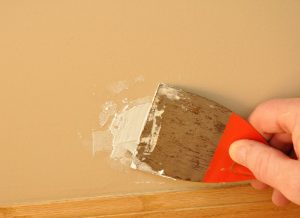
Drywall Damage and How to Fix it
Posted on December 3, 2019
A crack in your drywall can simply ruin a paint job. Sometimes those drywall cracks are more worrisome than just a flaw in your paint job. Learn how to determine if they mean more trouble, and how to fix them.
Where do drywall cracks come from?
More often than not, wall cracks are the result of an older home settling. It’s a nuisance, but not necessarily an omen of high-cost repairs. Sometimes a newer home will exhibit cracks because it was built with ‘green lumber’ which contains a high level of moisture. As it dries out, the cracks appear. If your home is newer and showing cracks, it’s a good idea to give it up to a year to settle before beginning repairs.
Earthquakes can also cause cracks in drywall, here in Mission Viejo this is an unfortunate possibility, if you have reason to believe there is any structural damage it’s best you have the home looked at by a professional.
Why is my wall cracking?
Houses settle and move over time. The movement can cause cracks to appear in your walls. If you are noticing hairline cracks in walls and doorways, it’s most likely your home settling and nothing to worry about. There is a simple fix outlined below.
Homes that are left vacant for long periods of time often develop cracks from not being climate controlled. The changes in temperature and humidity can cause the wood and drywall to expand and contract often leaving cracks behind. Because these cracks are turning up from climate, not foundation, they are nothing to be concerned about.
If your crack is very thin and straight, it’s likely the result of bad taping. The seams between drywall sheets are typically taped with paper tape to create a flawless finish. If the tape wasn’t applied appropriately, it can pull from the wall and create a crack. Again, this is nothing to worry about.
Leaking windows or doors can cause damage to the drywall around the moisture and eventually cause cracking. Most likely, before the crack turns up, you’ll see bubbling, discoloration, or water running along the path from the leaky area. Once the leak is fixed and the drywall repaired, you won’t see another issue with this spot unless the leak returns.
Cracks that are large, jagged, diagonal, or erratic indicate a much larger problem. These are signs that the foundation of your home has sunken or shifted or other structural problems like wood rot or termite damage are going on. These are cracks to worry about and signs that the home is in danger. You’ll need a reputable builder or engineer to inspect your home and give you a full report of what is going on.
How do I fix cracks?
Use quality fiberglass mesh tape to cover your drywall crack. This ensures the crack won’t come back. Many homeowners decide to just apply joint compound or spackle over a crack. Because the crack is not truly repaired, it will be back.
Use Patch Plus Primer in a thin coat over the drywall tape. This patching agent is recommended by pros because it has primer included in the compound, cutting out the priming step.
Cracks in Drywall-3M Patch Plus Primer
Big Tip: when you buy 3M Patch Plus Primer at the hardware store make sure it hasn’t been opened. Otherwise, it might be bad and unusable. The same principle applies to any product that comes in a container (including pre-mixed joint compound).
Spread the mud down the middle of the tape, in a downward motion from the center. Once the spackle seems to be sticking, move upward to the top of the tape. Allow this to dry for at least 30 minutes before moving on.
Professionals suggest using a 6-inch putty knife to add a second coat of the Patch Plus. The new coating should be two inches to the right and left of the center of the tape. Use a bit more pressure on the side of the knife that is on drywall to feather the edge of the putty and create a seamless look. Allow ample dry time.
Sand with a fine grit to further feather the edges and create a good area to paint. Use a circular motion to blend in the patch.
Use a quality paintbrush or roller to paint over the patch and finish the wall.
Not interested in doing the steps yourself? Call our experts at 714-485-2883 for a free in-home estimate on your project from the pros at CertaPro of Orange County today!





